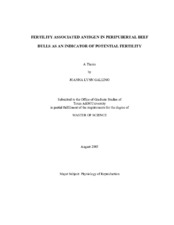| dc.description.abstract | Ejaculates from peripubertal Angus (n=106), Brahman (n=156) and Brangus
(n=212) bulls were evaluated for the presence of a 31 kDa protein known as fertility
associated antigen (FAA) using the ReproTest for Bulls (ReproTech, Tucson, AZ). This
study was designed to test the repeatability of FAA detection using the chute-side
cassette and to quantify the relationship of age, scrotal circumference, sperm motility,
ejaculate volume and sperm concentration with the presence of FAA in ejaculates from
peripubertal bulls. A total of 776 ejaculates were collected, and 77% (n=598) were
classified as FAA+. Three ejaculates were obtained from 133 bulls (Angus, n=33;
Brahman, n=100) on d 0, 30 and 60. Brahman bulls were older (p<0.0001) at puberty
than Angus bulls. Ejaculate volume was the only trait that differed between bulls that
were classified as FAA+ and FAA? at first collection. Mean ejaculate volume was
greater (p<0.0001) for FAA? than for FAA+ ejaculates. Serial ejaculates were profiled
according to one of four FAA classification patterns (0 = three FAA? ejaculates; 1 =
three FAA+ ejaculates; 2 = first ejaculate FAA?; and 3 = first ejaculate FAA+). A
majority of the bulls were FAA+ on all three ejaculates (57%) or at least on the first ejaculate (25%). Seven bulls (5%) were consistently FAA?, while the remaining bulls
(12%) were FAA? on the first ejaculate. There were no differences in scrotal
circumference or sperm concentration among FAA profiles. FAA profile-3 bulls were
older (p<0.05) than FAA profile-1 bulls at 2nd collection. Sperm motility was greater
(p<0.05) for FAA profile-1 than for FAA profile-3 bulls at 1st collection. Ejaculate
volume was greater (p<0.05) in FAA profile-0 Angus bulls than for FAA profile-1 at 1st
collection and in FAA profile-0 Brahman bulls than FAA profile-2 at 2nd collection.
These data indicate that FAA classification was not affected by sperm motility, sperm
concentration or scrotal circumference in peripubertal bulls. Repeatability of FAA
classification was higher for bulls that were FAA+ at first ejaculation. Thus, peripubertal
FAA? bulls should be re-evaluated to increase FAA-classification accuracy for
identification of higher fertility as well as lower fertility animals prior to breeding. | en |


